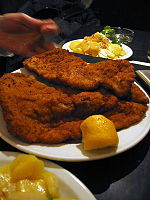Schnitzel: Difference between revisions
imported>Mary Ash No edit summary |
imported>Mary Ash |
||
| Line 7: | Line 7: | ||
==History == | ==History == | ||
The schnitzel recipe has a long and famous history that could date back to the seventh century of the [[Byzantine empire]]. The schnitzel is a famous dish from [[Austria]] although variations of this dish are eaten throughout Europe including [[Germany]], [[Italy]], and [[France]]. | The schnitzel recipe has a long and famous history that could date back to the seventh century of the [[Byzantine empire]]. The schnitzel is a famous dish from [[Austria]] although variations of this dish are eaten throughout Europe including [[Germany]], [[Italy]], and [[France]]. | ||
<ref name="urlBerliner Schnitzelstuga i Ytterån - The History of Wiener Schnitzel">{{cite web | |||
|url=http://www.berliner-schnitzelstuga.se/?The_History_of_Wiener_Schnitzel | |||
|title=Berliner Schnitzelstuga i Ytterån - The History of Wiener Schnitzel | |||
|url=http://www. | |||
|title= | |||
|format= | |format= | ||
|work= | |work= | ||
Revision as of 17:18, 8 August 2010
The schnitzel is usually prepared from a thin cutlet of veal although chicken or pork cutlets can be used instead of veal. Always cooked in butter or oil, the cutlet may or may not be sautéed as the cutlet may also be deep-fat fried. Variations of the schnitzel abound as this most famous recipe traveled throughout Europe.
History
The schnitzel recipe has a long and famous history that could date back to the seventh century of the Byzantine empire. The schnitzel is a famous dish from Austria although variations of this dish are eaten throughout Europe including Germany, Italy, and France. [1]
The practice of preparing meat wrapped in bread crumbs spread throughout Europe where this dish was discovered in Italy by Austrian Joseph Graf Radetzky in the 1800s. The dish Radetzky discovered was known as “Costoletta alla milanese” and was made from a thick slice of veal, coated in bread crumbs, then sautéed in butter.
Radetzky, served as commander of the Austrian troops from 1831 to 1857, shared the recipe with the kaiser as part of his duties to report military, political and culinary affairs in Italy.
After Radetzky shared the “Costoletta alla Milanese recipe, Austrian cooks perfected the recipe by pounding veal until it was a finger-width thick, dipped the cutlets in flour, egg and bread crumbs. The cutlets were cooked in hot fat until golden.[2][3] [4]
Ingredients and preparation
Veal schnitzels are traditional but variations include cooking pork or chicken cutlets instead. The same technique is used as for veal.
Schnitzels may also be prepared minus the breading an then they are known as au naturell or natur.[5][6]
The Wiener schnitzel originated from Vienna and is made from veal. This dish is often found at German restaurants too.[2][3]
Some ways to prepare schnitzels include Cheese schnitzel where the veal cutlet is prepared as for Wiener schnitzel. The cutlet is dipped in a half and half mixture of Parmesan cheese and bread crumbs. This dish is served with a lemon slice for garnish.
Almond schnitzels have veal dipped in sour cream then almonds before cooking.[7]
Similar dishes
Veal cordon bleu, Veal parmigiana and Veal scallop or Escalopede veau orloff all use similar cooking techniques as schnitzel. Veal cordon bleu has veal cutlets stuffed with prosciutto or smoked ham with Swiss cheese. The filling is sandwiched between veal cutlets, breaded and cooked in butter. Veal parmigiana is prepared by breading the cutlets in Parmesan cheese and bread crumbs then sautéing the cutlets in clarified butter. The cutlets are then served with a tomato sauce. Veal scallop has veal cutlets sautéed in clarified butter a soubise mixture of cooked rice, onions and mushrooms are sandwiched between the veal cutlets. The cutlets are then covered with a small amount of liver paste, sprinkled with brandy or dry sherry and then receive a sprinkling of Parmesan cheese. They are then baked until the cheese is golden.[8]
One of the best recipes using veal or pork schnitzel is Jager schnitzel. The cutlet is topped with a burgundy-mushroom sauce that may or may not be breaded.[2]
References
- ↑ Berliner Schnitzelstuga i Ytterån - The History of Wiener Schnitzel.
- ↑ 2.0 2.1 2.2 German Food Guide - Schnitzel. Cite error: Invalid
<ref>tag; name "urlGerman Food Guide - Schnitzel" defined multiple times with different content Cite error: Invalid<ref>tag; name "urlGerman Food Guide - Schnitzel" defined multiple times with different content - ↑ 3.0 3.1 Google Translate. Cite error: Invalid
<ref>tag; name "urlGoogle Translate" defined multiple times with different content - ↑ All About Wiener Schnitzel | The Hungarian Girl.
- ↑ Gary, Joy; Schuler, Elizabeth (1983). German cookery. New York: Crown Publishers. ISBN 0-517-50663-7.
- ↑ Wason, Betty (1967). German cookery. New York: Doubleday and Company. ISBN None.
- ↑ Sheraton, Mimi (1965). The German cookbook; a complete guide to mastering authentic German cooking. New York: Random House. ISBN 0-394-40138-7.
- ↑ Becker, Marion Rombauer; Rombauer, Irma von Starkloff (1975). Joy of cooking. Indianapolis: Bobbs-Merrill. ISBN 0-02-604570-2.


